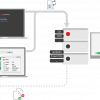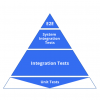Process
Articles
 |
Inverting the Test Automation Pyramid A growing company was tasked to develop a test automation program from scratch, change its coding practices, and build a continuous testing toolchain. Martin Ivison details how they did it, including realizing that implementing the traditional test pyramid wasn't going to work—it would have to be turned upside down. They found out that small is beautiful, cheap is good, and cultural change matters. |
|
 |
Test Everywhere: A Journey into DevOps and Continuous Testing A move to DevOps creates an opportunity to shift the testing process to the left. But what if you went further? DevOps supports continuous testing, so you can advocate for a constant focus on quality, with testing permeating the entire software development process. Here's how you can actually have a faster testing process when the software is tested throughout the lifecycle, by developers, testers, and automation alike. |
|
 |
6 Steps for Succeeding with Test Automation in Agile Lots of test automation efforts in agile software development fail, or at least do not maximize their potential. This article looks at two main reasons test automation may not live up to the expectations that testers and other stakeholders in the agile development process have, then outlines six steps to avoid falling into these traps. Here's how to succeed with test automation in an agile environment. |
|
 |
Use the Rejected Defect Ratio to Improve Bug Reporting There are many metrics to measure the effectiveness of a testing team. One is the rejected defect ratio, or the number of rejected bug reports divided by the total submitted bug reports. You may think you want zero rejected bugs, but there are several reasons that’s not the case. Let's look at types of rejected bugs, see how they contribute to the rejected defect ratio, and explore the right ratio for your team. |
|
 |
Who Should Set Up Continuous Integration for Automated Tests? If you want to trigger long-running, end-to-end automated tests, you must integrate the test execution system with the continuous integration system. But this job falls in a fuzzy area that meets at the nexus of feature development, test automation development, quality assurance, and build and release engineering. Here's how to decide who should be responsible for the setup. |
|
 |
Shifting Right Offers New Possibilities for Agile and DevOps Teams The shift-right concept originates from testing. But agile and DevOps teams also can use it to improve their systems and service to the client. However, there is a complicating factor: Different people have different explanations for what shifting right is. Let’s look at the different forms of shifting right, what the potential benefits are, and who should ideally be involved in your shift-right process. |
|
 |
Build Just Enough of a Feature with ATDD Developers have a tendency to overbuild their code. This is frequently due to not knowing exactly when they're done and not knowing how robust a feature needs to be. Acceptance test-driven development (ATDD) is a great way to avoid this practice because when the acceptance test passes, the developer knows they're done building that particular feature. |
|
 |
Is All Testing Exploratory? A Slack Takeover with Michael Bolton Thought leaders from the software community are taking over the TechWell Hub for a day to answer questions and engage in conversations. Michael Bolton, a speaker and thought leader in the testing industry, hosted this Slack takeover, which led to discussions about test exploration, tools, and testers as gatekeepers. |
|
 |
The Eroding Agile Test Pyramid The test pyramid is a great model for designing your test portfolio. However, the bottom tends to fall out when you shift from progression testing to regression testing. The tests start failing, eroding the number of working unit tests at the base of your pyramid. If you don't have the development resources required for continuous unit test maintenance, there are still things you can do. |
|
 |
Shifting Your Testing: When to Switch Gears Shifting your testing either left or right can meet different needs and improve different aspects. How do you know whether to make a change? Let your test cycles be your guide. Just like when driving a car with a manual transmission, if the engine starts to whine or you’re afraid you’re about to stall out, switching gears may be just what you need. |












